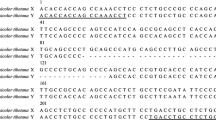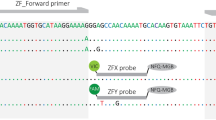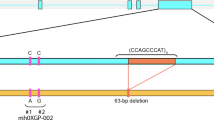Abstract
We developed a reliable noninvasive PCR method for sex identification of the Gentoo penguin (Pygoscelis papua) based on the amplification of the chromobox-helicase DNA-binding (CHD) gene. Two sets of nested primers (F1/R1, F2/R2) were designed to amplify the introns of the CHD1W and CHD1Z genes. The fecal samples were lysed in an optimized lysis reagent containing PCR buffer. The fecal lysate was employed as the template DNA to perform PCR amplification. Following nested PCR, agarose gel electrophoresis was performed, and the amplicons exhibited a sex-specific band pattern (211 bp and 315 bp in females, 211 bp in males). There was no amplification failure of our specific primers in 14 tested samples (7 males and 7 females), and the results of genotypic identification matched the records of sex based on oviposition behavior and pairing combination (based on the monogamy of the Gentoo penguin). The preliminary results showed that these nested primers could also be used for sex identification of Chinstrap penguins (Pygoscelis antarctica) and King penguins (Aptenodytes patagonicus). In conclusion, we successfully sexed Gentoo penguins using DNA extracted from fecal samples and performed nested PCR of sex-specific CHD genes.




Similar content being viewed by others
Data availability
All data generated during this study are included in this published article and its supplemental information.
Consent for publication
Not applicable.
References
Bermúdez-Humarán LG, García-García A, Leal-Garza CH, Riojas-Valdes VM, Jaramillo-Rangel G, Montes-de-Oca-Luna R (2002) Molecular sexing of monomorphic endangered Ara birds. J Exp Zool 292(7):677–680
Boutette JB, Ramsay EC, Potgieter LND (2002) An improved polymerase chain reaction-restriction fragment length polymorphism assay for gender identification in birds. J Avian Med Surg 16:198–202
Dawson DA, Brekke P, dos Remedios N, Horsburgh GJ (2015) A marker suitable for sex-typing birds from degraded samples. Conserv Genet Resour 7:337–343
Dawson DA, Horsburgh GJ, Krupa AP, Stewart IRK, Skjelseth S, Jensen H, Ball AD, Spurgin LG, Mannarelli M-E, Nakagawa S, Schroeder S, Vangestel C, Hinten GN, Burke T (2012) Microsatellite resources for Passeridae species: a predicted microsatellite map of the house sparrow Passer domesticus. Mol Ecol Resour 12:501–523
Dunn MJ, Jackson JA, Adlard S, Lynnes AS, Briggs DR, Fox D, Waluda CM (2016) Population size and decadal trends of three penguin species nesting at Signy Island, South Orkney Islands. PLoS ONE 11(10):e0164025
Ellegren H (1996) First gene on the avian W chromosome (CHD) provides a tag for universal sexing of non-ratite birds. Proc Biol Sci 263:1635–1641
Fridolfsson A, Ellegren H (1999) A simple and universal method for molecular sexing of non-ratite birds. J Avian Biol 30:116–121
Griffiths R, Daan S, Dijkstra C (1996) Sex identification in birds using two CHD genes. P Roy Soc Lond B Bio 263:1251–1256
Griffiths R, Double MC, Orr K, Dawson RJ (1998) A DNA test to sex most birds. Mol Ecol 7(8):1071–1075
Griffiths R, Tiwari B (1995) Sex of the last wild Spix’s macaw. Nature 375:454
Kahn NW, John JS, Quinn TW (1998) Chromosome-specific intron size differences in the avian CHD gene provide an efficient method for sex identification in birds. Auk 115:1074–1078
Kim T, Jang M, Kang H, Song C, Seo K (2014) Sex identification of Jackass Penguins (Spheniscus demersus) using the CHD gene. J Agric Life Sci 48(6):207–213
Nota Y, Takenaka O (1999) DNA extraction from urine and sex identification of birds. Mol Ecol 8(7):1237–1238
Taberlet P, Gordon L (1999) Non-invasive genetic sampling and individual identification. Biol J Linn Soc 68:41–55
Xu X, Lin L, Zhang Z, Shen F, Zhang L, Yue BS (2007) A reliable, non-invasive PCR method for giant panda (Ailuropoda melanoleuca) sex identification. Conserv Genet 9(3):739–741
Zhang P, Han J, Liu Q, Zhang J, Zhang X (2012) Sex identification of four penguin species using locus-specific PCR. Zoo BiolDOI: 10.1002 = zoo.21005
Zhou M, Yu J, Xue R, Li B, Yang J (2019) A reliable non-invasive PCR method for takin (Budorcas taxicolor) sex identification based on amelogenin gene. Conserv Genet Resour 11:89–92
Acknowledgements
We gratefully acknowledge Mr. Shengjiu Zhang, Director of Dalian Sun Asia Tourism Holding Co., Ltd., Dalian, Liaoning, People’s Republic of China, for taking a keen interest and supporting this work.
Funding
This study was supported by the Foundation of Liaoning Province Department of Ocean and Fisheries, China (201812/201822) and Key Research and Development Project of Liaoning Province, China (2018228004).
Author information
Authors and Affiliations
Contributions
WL conceived and designed the experiments. JT wrote the manuscript. JD revised the manuscript. ZL provided critical advice. XB, YL and ZF performed the experiments. All authors read and approved the final manuscript.
Corresponding author
Ethics declarations
Conflict of interest
The authors declare that they have no competing interests.
Informed consent
Not applicable.
Additional information
Publisher’s note
Springer Nature remains neutral with regard to jurisdictional claims in published maps and institutional affiliations.
Supplementary Information
Below is the link to the electronic supplementary material.
Rights and permissions
About this article
Cite this article
Tian, J., Bao, X., Du, J. et al. Sex identification based on the CHD gene from Gentoo penguin (Pygoscelis papua) fecal DNA samples. Conservation Genet Resour 13, 249–253 (2021). https://doi.org/10.1007/s12686-021-01202-x
Received:
Accepted:
Published:
Issue Date:
DOI: https://doi.org/10.1007/s12686-021-01202-x




